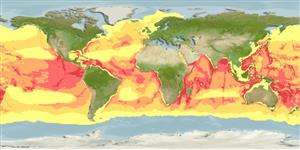Common names from other countries
Classification / Names / Names
Nomi Comuni | Sinonimi | Catalog of Fishes (gen., sp.) | ITIS | CoL | WoRMS
Environment: milieu / climate zone / depth range / distribution range
Ecologia
Pelagico; oceanodromo (Ref. 75906); distribuzione batimetrica 0 - 5300 m (Ref. 116169). Tropical; 22°C - ? (Ref. 75906); 90°N - 90°S, 180°W - 180°E
Atlantic Ocean and Indo-Pacific: Stenella attenuata graffmani: Gulf of California and Colombia; Stenella attenuata subspecies A: Hawaii; Stenella attenuata subspecies B: Baja California Sur, Colombia. Tropical to temperate.
Length at first maturity / Size / Peso / Age
Maturity: Lm 182.0 range ? - ? cm Max length : 260 cm TL maschio/sesso non determinato; (Ref. 1394); 240 cm TL (female); Peso massimo pubblicato: 120.0 kg (Ref. 1394)
Major threats to this species is incidental catches specifically by tuna fishermen in the eastern Pacific, and as sustainable by-catch with the use of gillnets in the Pacific and northern Indian Ocean (Ref. 85211). Spends the majority of their day nearshore, often between 90 to 300 m (Ref. 122680 but they also frequent oceanic waters (Ref. 801). They move further offshore at night into deeper waters to search for prey (Ref. 122680). Feeds largely on epipelagic fish and squid (Ref. 1394). It associates with parasites such as nematodes, cestodes, trematodes and acanthocephalans and commensals that includes cyamids amphipod, and barnacles (Ref. 85211). Social groups are formed by a range of a few individuals to thousands. It is composed of cow-calf pairs, adults and juveniles and they are grouped together or separately by juveniles or breeding groups. Their school size varies within the day (Ref. 85211).
Tan, J.M.L. 1995. (Ref. 936)
IUCN Red List Status (Ref. 130435)
CITES status (Ref. 108899)
Human uses
Pesca: commerciale
FAO - pesca: landings, species profile | FishSource | Sea Around Us
Strumenti
Fonti Internet
Estimates based on models
Preferred temperature
(Ref.
115969): 2.3 - 5.6, mean 3.5 (based on 2741 cells).
Resilienza
Medio, tempo minimo di raddoppiamento della popolazione 1.4 - 4.4 anni (K=0.2-0.37; tm=12).
Vulnerability
Very high vulnerability (84 of 100).
Price category
Unknown.
